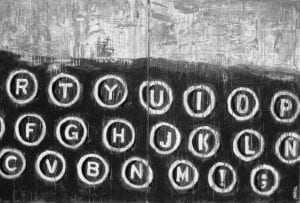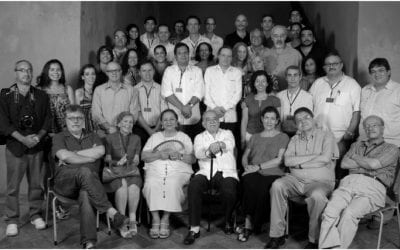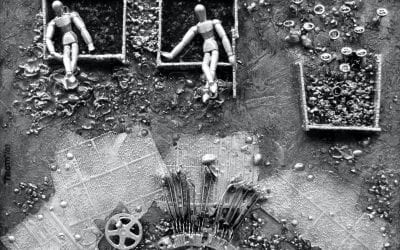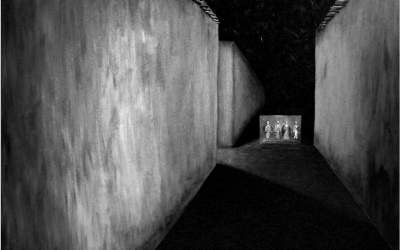Beyond Intimidation and Exile
The Revival of Investigative Reporting
I wrote my first investigative story on a sturdy Olivetti typewriter, thoughts pounding into the paper with an irregular staccato that would slow down as night approached dawn. That was back in early 1982. I was a reporter at Peru’s Caretas, a weekly newsmagazine, already grasping the fundamental dynamics of much of Latin American investigative reporting: Publish, try not to perish. I was fortunate to work with a great editor—the talented and brave Enrique Zileri. He was the magazine’s hard driving director, who could inspire or terrify Caretas’ eclectic group of journalists with a simple, binary alternative: Produce a scoop or suffer temporal but stinging disgrace.
In later years I would learn through personal experiences and those of my colleagues that the greatest hazard a Latin American investigative journalist faces is an internal one. It is the censorship and sabotage that emanates from the top of the enterprise—the owners and managers—trickling down through pliable editors until it settles into frequently corrupted newsrooms.
As editor and publisher of Caretas, Zileri stood out as a valuable exception. There is no telling what an experienced, relentless editor can accomplish by pushing, spurring, cajoling, sometimes even praising reporters into bringing back the best possible information. Of course, this ought to be what every editor does, and yet it is a rare newsroom in Latin America lucky enough to have such an editor.
Hazards of Reporting
In covering the Shining Path’s bloody insurgency during the 1980’s, for instance, my weekly task was straightforward: to find out and report what was happening in the fast growing scenarios of violence. With the surreal expressions of the Shining Path’s Cultural Revolution kind of Maoism and the lethal schizophrenia of the Peruvian government’s repression in play, reporting was admittedly arduous, though within the expected hazards of journalism. I found the obstacles and perils in the field were nicely counterweighted by fear of failure were I ever to return empty-handed to the newsroom.
Reporting was defined differently at other news organizations in Peru. Journalists there were expected to gather allegations that would support their publication’s ideology or to concoct reports that were more exorcism than information. For a long time, Peru’s newspaper of record almost didn’t report on the raging internal war, as if disdainful silence would dissipate it into oblivion.
Reporting on high-level corruption was close to impossible in most of Peru’s publications. Early in my journalism career I found out why; corruption was not aberrant but systemic, with networked nodes interlinked in sometimes surprising ways. In late 1983 I wrote my first exposé on Vladimiro Montesinos, who fled the country because of the story’s publication. But then he came back and piggybacked his way into power by being a secret adviser to people in power with much greater ambitions than capabilities. The fact that he was a natural as a spy didn’t harm either. His path to power was fraught with crimes but eventually he found himself as the adviser in the shadows to the insecure newly elected President Alberto Fujimori.
This was in 1990. In slightly over a year, Montesinos purged and secured control over the military, police and, chiefly, the intelligence services. He also developed a close relationship with the U.S. Central Intelligence Agency (CIA) that was to last through the decade, even as he assumed informal control of the primary activity of organized crime in Peru—drug trafficking. (This was not the only such case in Latin America of these overlapping connections—Panama’s Manuel Antonio Noriega comes to mind—but Montesinos was by far the smarter crook.) In less than two years he and Fujimori carried out an internal president-led coup d’état that when the dust settled left them with undisputed control over all branches of government.
In the process, I was seized and “disappeared” by the Army’s intelligence service, and then I reappeared thanks to their poor operational planning. Eventually I found myself unemployable; even some longtime friends were afraid of being seen with me at the time. Facing these pressures, I had to leave Peru some months later.
Soon I would find out that using journalism to expose the actions of Montesinos abroad, especially in the U.S., was almost as difficult as it was in Peru, though for different reasons. Editors were fine with publishing a story or an op-ed I wrote on many Latin American subjects, but they refused to even consider publishing investigative stories on Montesinos or Fujimori, no matter how meticulously I had researched them.
What was solid, well-documented investigative journalism—that would have been seen as such under normal circumstances—was dismissed as crusading journalism or even conspiracy-theory journalism when the subject was Montesinos. But that is not the point of this story. It is that as a good spy Montesinos documented almost everything that could be of use to him later on—dirty deals, transactions, betrayals. Before his time, East Germany’s Ministry for State Security, known as the Stasi, had pioneered overdocumentation of both surveillance and espionage. Mostly through videotape, Montesinos did the same, clearly with the thought that the information would be perpetually under his control. In that presumption, he was wrong.
What the Videos Revealed
When the Fujimori regime crumbled in 2000, a significant though incomplete set of Montesinos’s tapes was seized by the new regime. This prompted investigations by a number of official anticorruption entities whose zeal would soon ebb. But the dozens of videotapes remained a valuable contribution of Montesinos to the field of corruption studies. They were minimalist theater at its best: same room, furnished with a Third World bureaucrat’s notion of official opulence; same interlocutor: a usually silky Montesinos (perhaps more intimidating because of that), buying, bribing, conniving with a long parade of captains of industry and finance, politicians, judges, prosecutors and, last but not least, media owners.
The owners of almost all of the nation’s TV companies, its most important radio station, and many of Peru’s newspapers received editorial instructions from Montesinos. Here he is, on the tapes, telling them what and how to report—a lesson in disinformation. There are videos of owners being handed piles of cash, money they took at times with a greed bordering on lust. Today, a few of the less powerful ones are in prison; one is a fugitive, living comfortably in Switzerland with his son now in control of his TV station. Most are even better off than they were then. They retain control of their media companies, banks and businesses, and have increased their large leverage over economic activity, political discourse and, to a large extent, media output.
Presidential Corruption in Panama
I also lived through those sorts of dynamics at work in another latitude. In 1996, I was hired to be the deputy director of Panama’s La Prensa. My task was straightforward: to strengthen the paper’s investigative journalism. La Prensa founder Roberto Eisenmann and I were Nieman Fellows together in 1985-’86 and through the years we encouraged each other as we confronted autocrats in our respective countries, he with Noriega, then me with Fujimori and Montesinos.
In structuring the ownership of La Prensa, Eisenmann was visionary. Given the dictatorship in place and knowing that any major investor would have his arm twisted in no time by government officials, La Prensa spread its ownership widely. No person could own more than one percent of the newspaper’s shares. That way, its board and its editors were able to do independent journalism. Confronting first Omar Torrijos and then the far more vicious Noriega, La Prensa held strongly to its values, paid a painful price in that struggle, and after Noriega’s downfall reopened with great prestige, soon becoming profitable and the newspaper of record in Panama.
This was a newspaper that any reporter would be proud to work for, as I was. I put myself energetically to the task of doing investigative reporting—with no better place to start than with the country’s financial sector. The first investigation I led was on the fraudulent collapse of a bank. As long as those brought into the limelight were foreigners or relative unknowns, there wasn’t a problem. But in time (as would be the case in all other major investigations) the corrupt bankers led to an important Colombian drug trafficker, then to people with high influence in Panama’s regime, then to the president’s son-in-law.
President Ernesto Pérez Balladares decided to expel me from Panama. I decided to resist and a standoff ensued for several months. The paper’s board, especially its president, Juan Arias, firmly supported me, which made a huge difference. But support for me was far from unanimous at the newspaper. One of La Prensa’s founders, Ricardo Alberto Arias, was at the time Panama’s foreign minister, and he sided strongly with the president. At one point in the midst of swiftly aborted direct talks, he told me that he believed that only a person with at least three generations of ancestors buried in Panama’s soil should be allowed to do investigative reporting in the country.
In the end I was able to stay. I continued my work there for five years, exposing many more cases of corruption, some implicating President Pérez Balladares. As a result of one story, he was stripped of his U.S. visa. Afterwards, Panama’s attorney general made a point by indicting and suing me and the other members of the investigative team, just as he had after the publication of other significant exposés.
The support I received from Juan Arias, La Prensa’s board president, was crucial to do these investigations. But after nearly five years he decided to step down. At that point, Ricardo Alberto Arias, now no longer foreign minister, led a laborious takeover drive to win enough shareholders’ votes to take control of the paper. He took over La Prensa in 2001. I had left Panama a few months before and returned to Peru, but excellent journalists who had worked with me were exiled to minor positions at the paper as Arias tried and for a time succeeded in neutralizing its investigative power.
What the crooks couldn’t do from outside, they were now able to do from within. The situation had a positive turn of events, which to this day holds. Fernando Berguido, a 2011 Nieman Fellow, became La Prensa’s publisher in 2004—and for two years also its editor—and put it back on track. A top Panamanian investigative journalist, Rolando Rodríguez, was appointed associate director, and he steered La Prensa into uncovering cases of corruption, old and new. He eventually reported on the house arrest, however brief, of Pérez Balladares as part of the prosecution for past, let’s say, misdeeds.
The Digital Path
Panama’s La Prensa and Zileri’s Caretas were exceptional places where investigative journalism was encouraged and defended, though both had to pay a price for doing it. All over Latin America, the number of newspapers, magazines and electronic media that have an uncompromising approach to investigate high-level corruption is exceedingly small. It is noteworthy, therefore, how many important investigative stories have been published in Latin America since the 1980s. Yet these represent just a fraction of what is needed if journalists, as the public’s watchdogs, are to have a substantial and sustainable impact on corruption.
Since this past February I have been at IDL-Reporteros (reporteros.pe), a small, web-based, nonprofit investigative publication in Peru that I co-founded and direct. The equivalent to our publisher is Peru’s foremost human rights organization, IDL (Instituto de Defensa Legal). Our financial support is from the Open Society Institute, which is the principal funder for an expanding crop of Latin American nonprofit investigative journalism units. We are part of a Latin American—and a global—effort to stem and reverse the decay of investigative journalism.
Ours is a pioneering effort striving to find a sustainable model while trying to do and publish the best possible investigative journalism. It is too early to know which of the trails we are blazing will become well-traveled roads and which might be abandoned. Digital media present us with exhilarating possibilities for ushering in a new era of significant investigative journalism. But whether a thoroughly investigated exposé that makes it harder for powerful crooks to steal, extort or intimidate comes from a typewriter or is produced on a digital tablet, its existence—then and now—represents success.
Spring 2013, Volume XII, Number 3
Gustavo Gorriti, a 1986 Nieman Fellow at Harvard, is the founder and director of IDL-Reporteros, a digital, nonprofit investigative publication in Peru. Last year the Ibero-American New Journalism Foundation (FNPI) honored him with its CEMIX+FNPI New Journalism Prize in recognition of his outstanding career as an investigative journalist.
A version of this article appeared in the March 2011 Nieman Reports.
Related Articles
New Journalists for a New World
I received a surprising phone call one day in late 1993, when I was the director of Telecaribe, a public television channel in Barranquilla, Colombia. The caller was none other than Gabriel García Márquez. “Will you invite me to dinner?” he asked me. “Of course, Gabito,” I…
Latin American Nieman Fellows
A few days after I arrived at Harvard in August 2000 to begin my work as curator of the Nieman Foundation for Journalism, Tim Golden, an investigative reporter for the New York Times in Latin America, phoned me. “Could I find a place in the new Nieman class for a Colombian…
Freedom of Expression in Latin America
In June 1997, Chile’s Supreme Court upheld a ban on the film “The Last Temptation of Christ,” based on a Pinochet-era provision of the country’s constitution. Four years later, the Inter-American Court of Human Rights heard a challenge to this ban and issued a very different…





